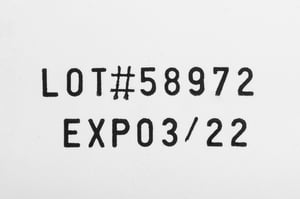
Inkjet codes on products and packaging communicate essential production information for the food and beverage industry, medicine packaging, and more. Federal rules and regulations exist for these industries and products to ensure that labeling and coding are clear and correct for traceability and consumer protection purposes. Such regulations seek to prevent misinformation that could be harmful to retailers and consumers.
If you are in one of these industries or any other that uses inkjet coding, you should already be well-versed in this information, but a refresher is sometimes helpful. Lucky for you, here is a quick review of the different types of date coding you should know.
Expiration or Expiry Dates
A product’s packaging may refer to expiration dates in multiple ways, including “best by,” “use by,” or “sell by” dates. This information allows for the retailers to know when they should pull the product off the shelf and when the consumer should no longer consume or use the product. This type of quality control keeps the individuals who use and buy these products safe.
Packaging Dates
This type of date coding is self-explanatory—it indicates when product packaging occurred. The information typically doesn’t matter to the consumers themselves; however, it is important to the manufacturers and retailers that track inventory, rotate items, and locate items for recall purposes.
Batch or Lot Codes
These two terms are sometimes interchangeable. This type of inkjet code is applied to all individual products or packages produced within a specific batch for quality assurance purposes. It can include the production time, production date, and identification codes. Sometimes a manufacturer can have multiple batches within one lot - the inkjet code will need to reflect a unique batch code and lot code identifier in these instances.
While these three types of inkjet coding are not the only ones that manufacturers use throughout the industries, they are some of the most common. We hope this information will set a foundation for you on the specific types of date coding you should know. Here at Sneed Coding Inc., we want to do our part to #KeepCodingSimple and supply our customers with the right resources. Speaking of supplies, if you are in the market for a new industrial inkjet coder or even a handheld date code printer, visit our website or call us today!


